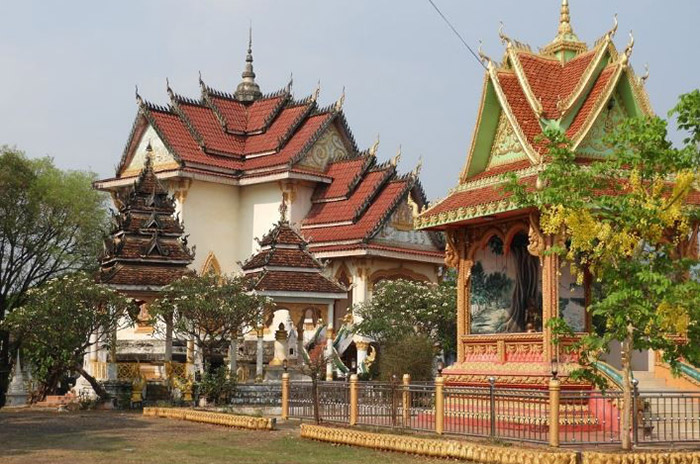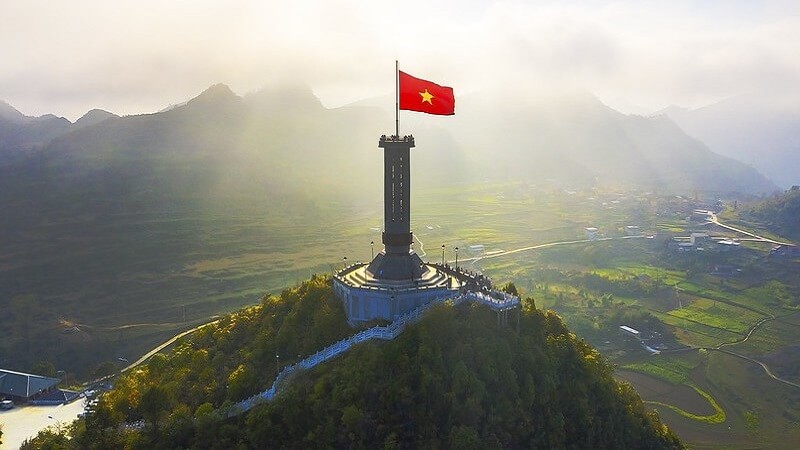Explore Wat Phabat the Footprints of Buddha
Amidst the backdrop of longstanding friendly relations, special solidarity, and comprehensive cooperation between Vietnam and Laos, the land of Laos beckons with its abundant potential in terms of land, minerals, and tourism. Laos has become a destination coveted by foreign investors looking to showcase their business acumen and talents.
Footprints of Buddha, Forests, Waterfalls, and the Journey of Wat Phabat
Located in Central Laos, Bolikhamxay is about 150km south of Vientiane. A drive of approximately 2 hours from Vientiane will lead you to Paksan, the provincial capital of Bolikhamxay. En route, if you have some time, you can stop by Phabath Temple (Wat Phabath) located by the roadside, about 50km north of Paksan.
Wat Phabat – An Unmissable Destination in the Bolikhamxay Discovery Journey
Considered one of the most sacred temples, Wat Phabat is an essential pilgrimage site for visitors to Bolikhamxay. The story goes that in the early 1990s, locals discovered a 2.4 x 1.2 meter footprint of Buddha deeply embedded in a rock. In response, they built a temple named Phabath (Footprint of Buddha) at the site. Over the years, pilgrims and tourists have adorned the footprint with gold leaf, making it shine even brighter. Every year on the full moon day of January, the temple hosts a festival to pay homage to Phabath.
Wat Phabath is a complex of structures situated on a hillside next to National Highway 13. The remnants of ancient trees within the temple grounds indicate that the area was once a dense forest with large and rare trees. The statues within the temple are made from clay, stone, or precious wood, likely sourced from the surrounding forest.
The Buddha statues here are adorned with a sacred blue dragon, symbolizing reverence for Buddha and the desire for his protection from the natural disasters that can befall humans.
Both Lao locals and travelers passing through from North to South Laos make time to visit Wat Phabat, offer prayers, and make offerings. Everyone hopes to lay eyes on the sacred “footprint” left by Buddha and seeks safety and good fortune for their journey.
Nearby is Wat Phonsane, located on a lush riverside area along the Mekong River. It is believed that Buddha once dined at this site during his journey of spreading teachings. The temple is also known for the legendary Bang Fai Phayanak festival (Fireball Festival), celebrated in mid-November according to the Lao lunar calendar, coinciding with the last day of the Lao fasting period.
Bolikhamxay – A Haven of Ecotourism Wat Phabat
With two national conservation areas and an extensive wetland system, Bolikhamxay is renowned for its ecotourism offerings. Visitors can explore the wild nature with famous waterfalls like Tad Leu, Tad Xay, and Tad Xang, along with the diverse ecosystem of Nam Kading National Park, which is home to various wild animals such as elephants, tigers, gibbons, and black langurs.
One of the largest wetland systems in the country is situated to the southwest of Paksan. This area hosts abundant and unique migratory bird species. Travelers can reach the wetlands by motorcycle or high-clearance car on rough roads. En route from Paksan to the Namphao-Cau Treo international border crossing, travelers also witness the stunning landscapes of the Phou Phaman limestone mountain range and can even experience mountain ziplining to observe the pristine forests from above.

A Vision of Cross-Border Economic Prosperity Wat Phabat
Although Bolikhamxay serves as a gateway for trade with Vietnam, its economy still heavily relies on agriculture, contributing around 25% to the GDP. The industrial and construction sectors constitute nearly 46% of the GDP, mainly centered around mineral and energy extraction, such as gypsum, gold, and hydropower.
Bolikhamxay’s biggest potential lies in its land, which remains underutilized due to its small population of approximately 300,000 people. The Mekong River flows along the western border of the province, replenishing it with substantial fertile sediment for rice fields, cornfields, and lush vegetable gardens along the riverbanks. Fishing is a significant source of income for many local families. The fish caught here can be sold live, dried, salted, or made into fish sauce, creating a specialty that attracts passersby and visitors alike.
Over a decade ago, rubber trees started taking root in Bolikhamxay. Vietnamese companies such as Duc Hien Company and Toan Thang Company ventured into leasing land to plant rubber and collaborated with local residents to develop a rubber plantation model alongside National Highway 13. Today, several areas have begun rubber tapping.
A Bright Future Ahead
Recently, the Lao and Thai governments signed an agreement to build the fifth Friendship Bridge across the Mekong River, with an investment of over 1,000 billion Kip (equivalent to 3,000 billion VND). This 1,350-meter bridge will connect the provinces of Bueng Kan (Thailand) and Bolikhamxay (Laos), serving as a vital transport link to enhance trade and investment among Laos, Thailand, and Vietnam. This bridge will facilitate the movement of goods from Thailand to Bolikhamxay, shortening the journey by nearly 200 km along National Highway 8 via the Namphao-Cau Treo international border crossing, leading to Ha Tinh, Nghe An, and onward to Hanoi, Danang, or other parts of Vietnam.
Within the framework of the project, a new comprehensive economic zone at Friendship Bridge 5 will be established to capitalize on the bridge’s potential for connectivity between Laos and Thailand.
Bolikhamxay has laid the financial groundwork for the main project components and has already seen interest from two companies looking to invest in the complex economic zone, including commercial-service zones, logistics warehouses, tourist sites, and agricultural production areas with a commodity focus.
The policies to encourage investment, specific regulations on governance jurisdiction, land ownership, labor policies, commitments to provide capital, seedlings, techniques, and market access for agricultural projects in the Friendship Bridge 5 area have been established to attract investors to the region.
With the future construction of the Laos-Thailand Friendship Bridge and the Hanoi-Vientiane expressway, which will form an integrated transportation system, Bolikhamxay is expected to become a cross-border economic hub for Northern and Central Laos. Paks
>>> See more




